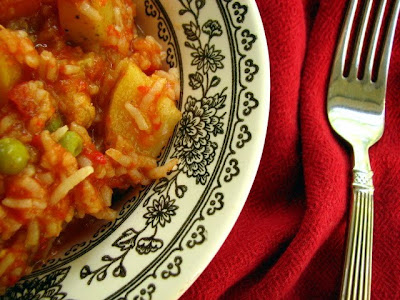
With the recent acquisition of my 3-in-1 slow cooker, I've been looking at a lot of new cookbooks in an attempt to move beyond the chili and bean soups I can make with my eyes closed. There seem to be two camps in the slow cooker world: those who slow cook for convenience, and those who slow cook for the added depth of flavor imparted by long hours over low heat.
There are a lot of slow cooker books out there, enough that I've had to develop my own simple litmus test to use while scanning for promising recipes. If onion soup mix or anything from Campbell's show up in the ingredient list, that's when I put the book down and move on.
I've had some hits (arroz con pollo) and some misses (Moroccan chicken) and learned a few things, namely that most things taste better if I take the time to brown meat, saute onions, and warm spices in oil. Oh, and that you really can overcook slow cooked dishes.
Tonight's dinner was delicious. I made a slow cooked kitchari from the wonderful Not Your Mother's Slow Cooker Book in which I've found interesting recipes with real ingredients--nary a can of cream of mushroom soup in sight! The recipe called for heating spices in melted butter to release their fragrance for the base flavors and the last hour spice paste addition gives a bright, fresh taste to this protein-rich Indian comfort food.
My modification: the recipe calls for moong dal but I used the split chana dal I had in the cupboard and was happy with the results, but they didn't completely disintegrate into the rice. If that sounds more appealing to you (or picky little ones) by all means use the moong dal or even red lentils. Also, though the recipe directed cooking on low heat, I cut the cooking time nearly in half by cooking on high. If you choose to do this, watch it at the end so it doesn't dry out too much.
 You'll find the printable recipe here. Enjoy!
You'll find the printable recipe here. Enjoy!Oh--and if, like me, you can't keep your dals straight, this is the guide I refer to.
![Reblog this post [with Zemanta]](http://img.zemanta.com/reblog_e.png?x-id=36854c9b-f779-43a5-af8c-008d3be91834)

![Reblog this post [with Zemanta]](http://img.zemanta.com/reblog_e.png?x-id=73b62e13-f08f-45bf-a9e5-e5300efe8531)

![Reblog this post [with Zemanta]](http://img.zemanta.com/reblog_e.png?x-id=873a91f0-bb92-4ad0-879e-84d2ab273aa8)


![Reblog this post [with Zemanta]](http://img.zemanta.com/reblog_e.png?x-id=dd4a0bf4-5895-4b5c-a679-3da384e73379)



![Reblog this post [with Zemanta]](http://img.zemanta.com/reblog_e.png?x-id=bf3c936c-4d6a-48d0-964d-f4a51e56e044)